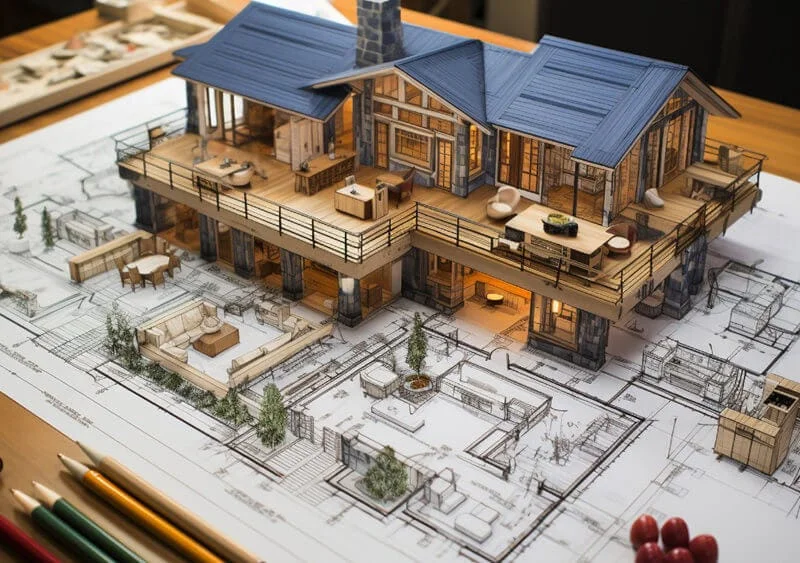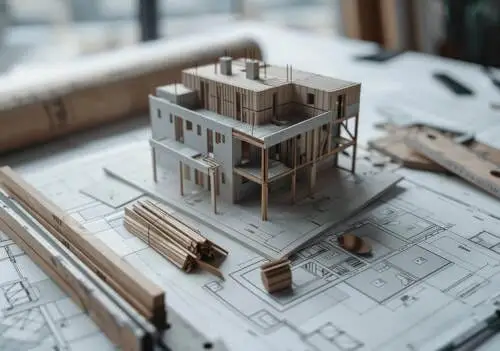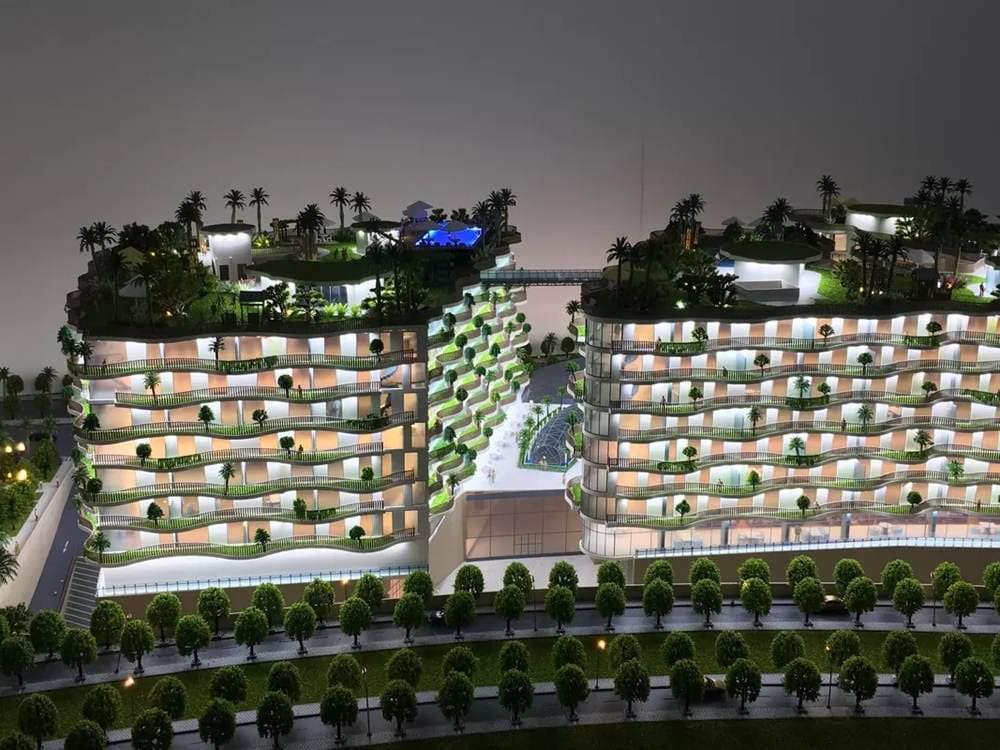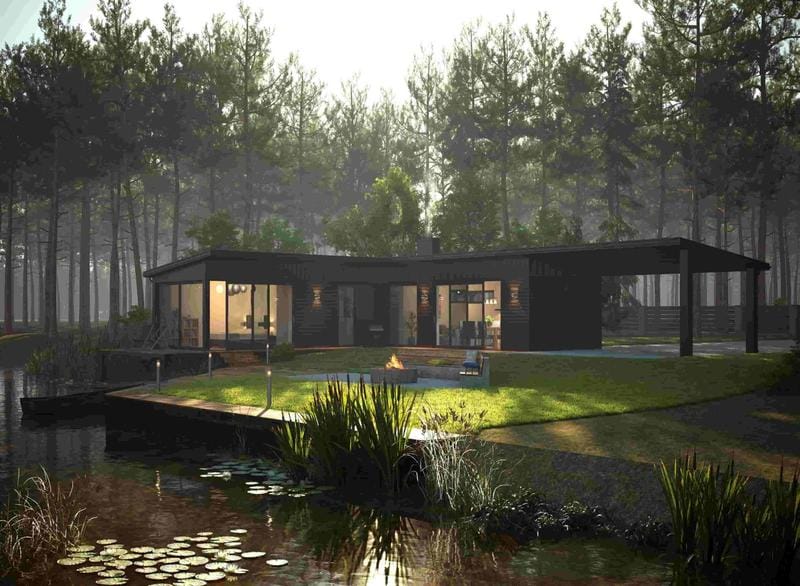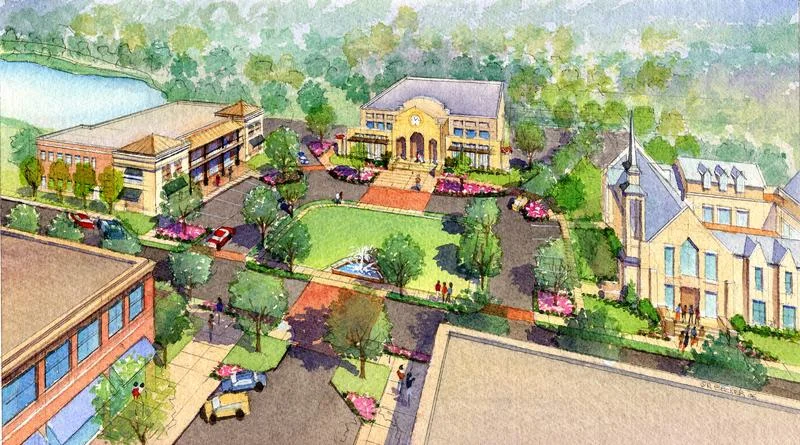건축모델의 세계에서, 건물은 쇼의 스타입니다. 하지만 프로젝트에 진정으로 생명을 불어넣는 것은, 믿을 수 있는 현실에 기반을 두는 것, 풍경이다. 잘 만들어진 풍경은 모델을 단순한 건축 연구에서 생활 공간으로 변화시킵니다., 숨쉬는 세상. 잔디의 질감이에요, 물의 반짝임, 정서적 연결을 형성하고 비전을 파는 나무들의 바스락거리는 소리. 이 가이드에서는 풍경 모델의 매혹적인 영역을 자세히 살펴봅니다., 그들의 목적을 탐구하다, 창조, 초현실주의를 달성하기 위한 전문적인 비결. 이 복잡한 창작물이 단순한 아름다운 디스플레이 그 이상인 이유를 알아보세요. 커뮤니케이션을 위한 강력한 도구입니다., 계획, 그리고 영감.
목차
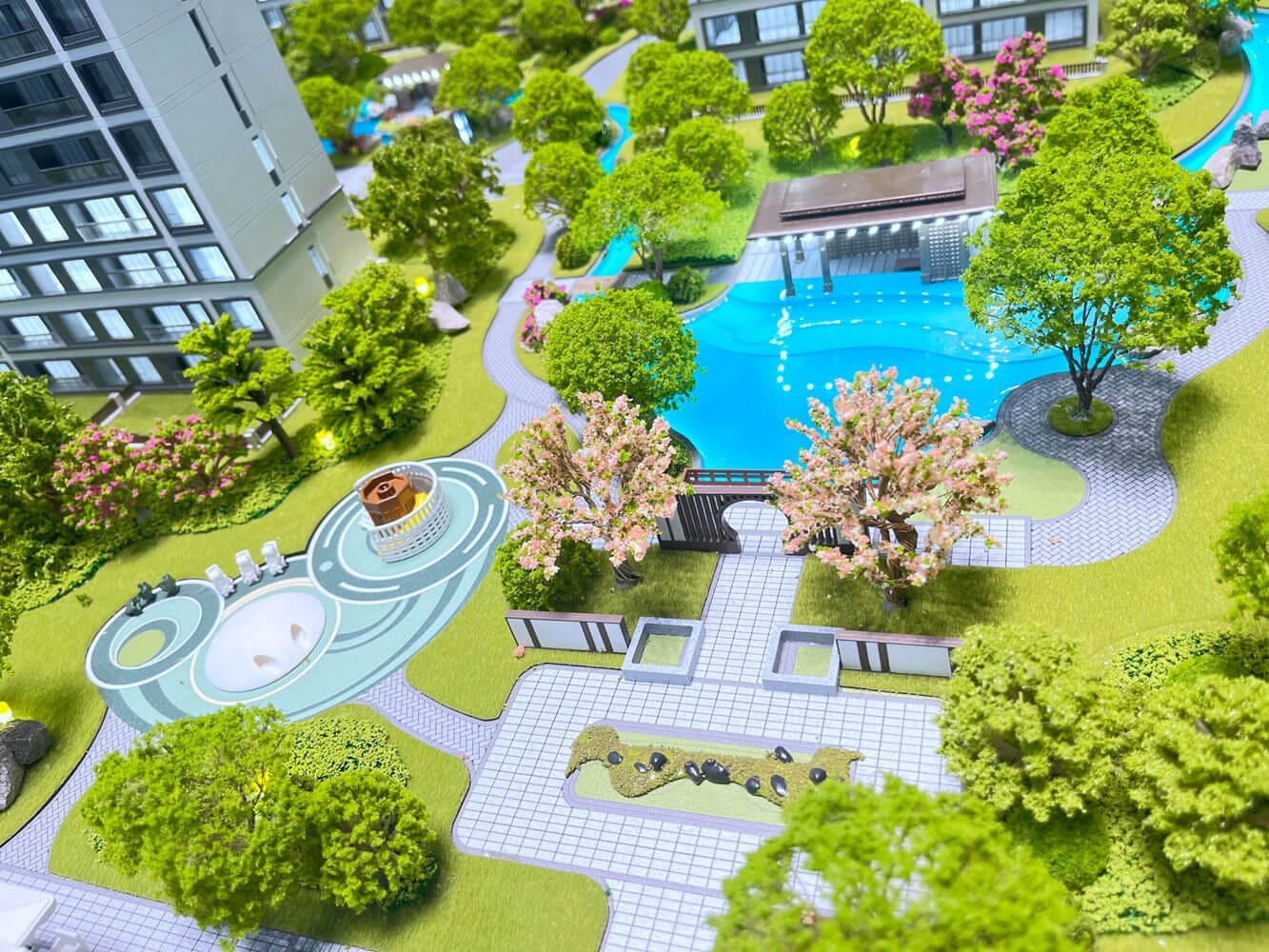
조경 모델이란 정확히 무엇입니까??
경관 모델은 지리적 영역을 3차원으로 표현한 것입니다., 건축 현장, 또는 축소된 규모의 도시 환경. 이러한 모델은 단순한 매스작업 연구부터 매우 상세한 지형 묘사까지 다양합니다., 초목, 건물, 그리고 인프라. 건축가에게 귀중한 도구 역할을 합니다., 도시 계획가, 조경가, 개발자, 디자인 개념을 전달하는 교육자와, 공간 관계 분석, 이해관계자 참여. 더 큰 프로젝트의 맥락에서, 이것은 우리가 말하는 것의 핵심 구성 요소입니다. 마스터플랜 모델의 예술.
조경 모델은 다양한 재료로 제작됩니다., 판지를 포함하여, 거품, 목재, 플라스틱, 심지어 3D 프린팅된 부품까지. 모델의 세부 사항과 사실성 수준은 의도된 목적과 고객의 요구 사항에 따라 다릅니다.. 일부 모델은 프로젝트의 전체적인 매스와 형태를 전달하는 데 중점을 둡니다., 다른 사람들은 모든 나무를 꼼꼼하게 복제하는 반면, 건물 외관, 그리고 거리의 고정물. 고품질의 조경 모델을 만드는 데 필요한 예술성과 장인 정신은 정말 놀랍습니다..
건축과 디자인에서 조경 모델이 중요한 이유?
조경 모델은 여러 가지 이유로 건축 및 설계 과정에서 중요한 역할을 합니다.. 첫째로, 2D 도면 및 렌더링으로는 비교할 수 없는 프로젝트에 대한 유형적이고 쉽게 이해할 수 있는 표현을 제공합니다.. 고객과 이해관계자는 모델 주위를 둘러볼 수 있습니다., 다른 각도에서 보기, 공간적 관계와 설계 의도에 대한 포괄적인 이해를 얻습니다.. 이것은 우리가 필라 페이지에서 다루는 기본 원칙입니다., 고급 건축 모델에 대한 궁극적 인 가이드.
둘째, 조경 모델은 설계 팀 간의 협업과 의사소통을 촉진합니다.. 건축가, 엔지니어, 조경가, 다른 컨설턴트는 모델을 토론의 초점으로 사용할 수 있습니다., 잠재적인 갈등을 식별, 공동으로 디자인을 개선하고. 이러한 반복 프로세스는 최종 프로젝트가 고객의 요구 사항을 충족하고 주변 환경과 원활하게 통합되도록 보장합니다..
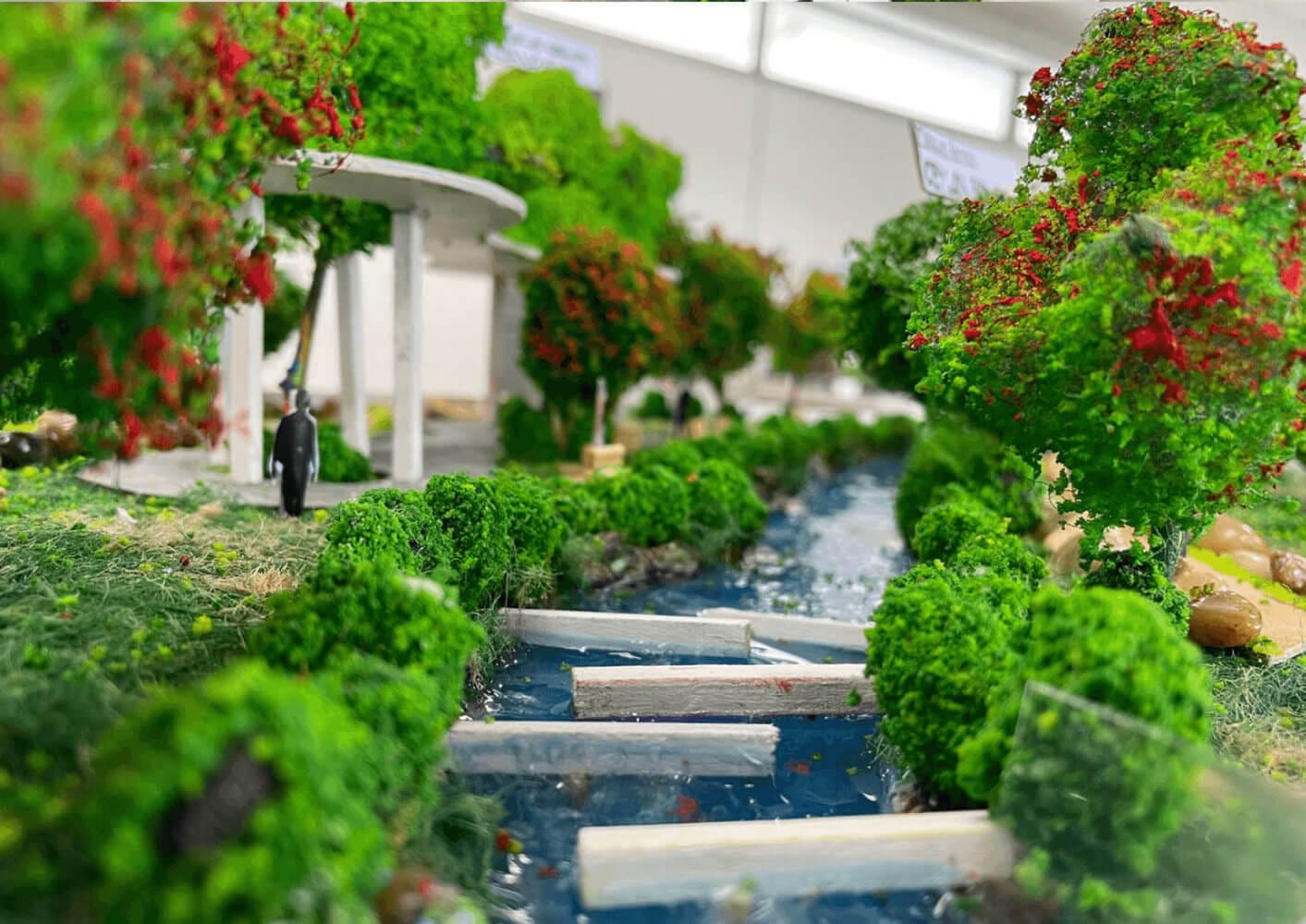
다양한 유형의 조경 모델은 무엇입니까?
조경 모델은 다양한 유형으로 제공됩니다., 각각은 특정 목적을 수행합니다.. 지형 모델 현장의 지형과 고도 변화를 표현하는 데 중점을 둡니다.. 이 모델은 배수 패턴을 이해하는 데 필수적입니다., 경사면 안정성, 프로젝트가 풍경에 미치는 시각적 영향. 건축 모델 건물과 구조물을 풍경에 통합, 건축 환경과 주변 환경의 관계를 보여줍니다.. 대규모 프로젝트의 경우, 풍경 모델 전반적인 마스터 플랜을 시각화하는 데 사용됩니다., 여러 건물을 포함해, 시가, 그리고 열린 공간.
개념적 모델 다양한 매스작업 및 레이아웃 옵션을 탐색하기 위해 설계 초기 단계에서 생성되는 경우가 많습니다.. 이러한 모델은 일반적으로 덜 상세하며 프로젝트의 전반적인 형태와 공간 구성에 중점을 둡니다.. 배심원의 마음을 사로잡을 수 있는 강력한 도구입니다., 우리가 탐구하는 전략 컨셉 모델이 경쟁에서 승리를 거두는 방법. 프레젠테이션 모델 매우 상세하고 현실적입니다., 고객과 이해관계자에게 깊은 인상을 주고 최종 디자인 의도를 보여주기 위한 것입니다.. 이러한 모델에는 종종 복잡한 조경이 포함됩니다., 조명, 심지어 미니어처 사람과 차량까지. 그리고 결정적인 점을 잊지 말자 건축 풍경 모델 구조와 환경 사이의 격차를 해소하는 것입니다..
조경 모델은 어떻게 생성됩니까?? 단계별 프로세스
조경 모델을 만드는 것은 기술이 필요한 다단계 프로세스입니다., 정도, 그리고 세부 사항에 대한 엄청난 관심. 사이트에 대한 정보를 수집하는 것부터 시작됩니다., 지형 조사를 포함한, 건축 도면, 및 조경 계획. 그런 다음 이 데이터는 기본 지도를 생성하고 모델의 적절한 축척을 결정하는 데 사용됩니다.. 올바른 규모를 선택하는 것이 중요한 첫 번째 단계입니다., 우리 가이드에서 자세히 설명하는 내용은 스케일과 세부 사항의 완벽한 균형을 찾습니다.
다음, 모델 제작자는 폼 층을 사용하여 지형을 구성합니다., 판지, 또는 기타 재료. 건물과 구조물이 추가됩니다., 나무와 같은 조경 요소가 뒤 따른다., 관목, 및 물 특징. 마지막으로, 도로 등 세부사항, 보도, 가로등, 모델에 생명을 불어넣기 위해 간판과 간판이 통합되었습니다.. 전체 프로세스에는 종종 수공예 기술과 디지털 제작 방법의 조합이 포함됩니다., 레이저 커팅, 3D 프린팅 등. 이러한 기술의 혼합은 우리가 탐구하는 것입니다. 현대 공예 대. 전통적인 수작업.
조경 모델 제작에 사용되는 재료?
조경 모델의 재료 선택은 원하는 세부 수준에 따라 다릅니다., 내구성, 그리고 예산. 전체 개요를 보려면, 당신은 우리의 상담해야합니다 모델 재료에 대한 종합 가이드. 일반적인 재료는 다음과 같습니다:
- 폼 보드: 가볍고 자르기 쉬움, 지형 및 건물 형태 생성에 이상적.
- 판지: 다재다능하고 저렴합니다, 매스 연구 및 개념 모델에 적합.
- 목재: 내구성이 뛰어나고 심미적으로 만족스럽습니다., 베이스보드 및 구조 요소에 자주 사용됩니다..
- 플라스틱: 다양한 형태로 이용 가능, 시트 포함, 막대, 그리고 튜브, 상세한 구성요소를 생성하기 위한.
- 아크릴: 투명하고 강함, 물 기능 및 보호 커버에 이상적.
- 3D 프린트 레진: 복잡하고 복잡한 모양 생성 가능, 우리가 탐구하는 기술 3D 프린팅 안내.
- 조경자재: 모델 트리 포함, 관목, 잔디, 자갈, 그리고 물 효과.
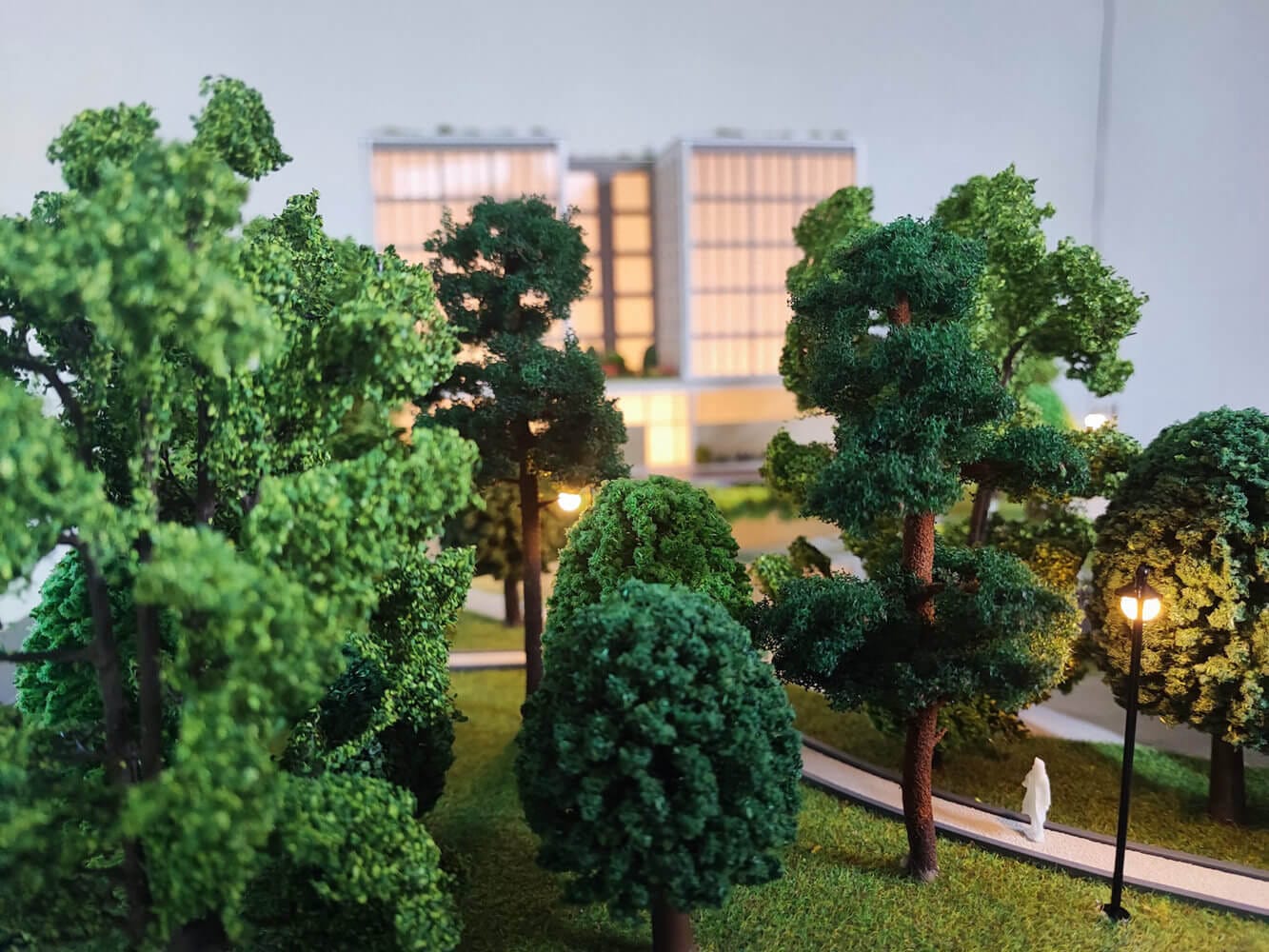
조경 모델이 의사소통과 협업을 강화하는 방법?
조경 모델은 기술 도면과 고객의 이해 사이의 격차를 해소하는 강력한 커뮤니케이션 도구입니다.. 이를 통해 건축가와 디자이너는 복잡한 공간 관계를 설명할 수 있습니다., 디자인 컨셉, 명확하고 접근 가능한 방식으로 환경에 미치는 영향. 고객은 제안된 프로젝트를 쉽게 시각화할 수 있습니다., 질문하다, 피드백을 제공하고, 보다 협력적이고 정보에 입각한 설계 프로세스로 이어집니다.. 이는 부동산에서 특히 중요합니다., 명확한 비전이 가능한 곳 매출에 큰 영향을 미침.
뿐만 아니라, 조경 모델은 디자인 팀의 다양한 구성원 간의 의사소통을 촉진합니다.. 엔지니어, 조경가, 다른 컨설턴트는 기술 문제를 논의하기 위한 공통 참조 지점으로 모델을 사용할 수 있습니다., 잠재적인 갈등을 식별, 그들의 업무를 조정하고. 이러한 협업 접근 방식은 최종 프로젝트가 잘 통합되고 모든 이해관계자의 요구 사항을 충족하도록 보장합니다.. 그리고 간단한 것이 필요하다면 모델 풍경 당신의 요점을 전달하기 위해, 그것에 대한 옵션도 많이 있습니다.
조경 모델 제작에서 기술의 역할은 무엇입니까?
기술은 조경 모델 제작 분야에 혁명을 일으켰습니다., 더 높은 정밀도 가능, 능률, 그리고 사실주의. 컴퓨터 지원 설계 (치사한 사람) 소프트웨어를 사용하면 모델 제작자가 현장과 건물의 정확한 디지털 표현을 만들 수 있습니다., 그런 다음 레이저 절단기 및 3D 프린터용 절단 패턴을 생성하는 데 사용할 수 있습니다..
레이저 절단 기술을 통해 다양한 재료로 복잡한 부품을 정확하고 빠르게 제작할 수 있습니다., 폼 보드와 같은, 아크릴, 그리고 나무. 3D 프린팅을 사용하면 복잡하고 유기적인 형태를 만들 수 있습니다., 나무와 같은, 조각품, 지형적 특징. 이러한 기술은 모델 제작 프로세스의 속도를 높일 뿐만 아니라 매우 상세하고 사실적인 표현을 생성할 수 있는 가능성을 확장합니다.. 이러한 기술을 소싱하는 것은 많은 기업이 탐색하는 주요 이유입니다. 중국의 이점 그들의 프로젝트를 위해.
조경 모델의 실제 적용 사례는 무엇입니까??
조경 모델은 다양한 용도로 사용됩니다., 포함:
- 건축 설계: 건물 형태 시각화, 공간 관계, 및 사이트 통합.
- 도시 계획: 제안된 개발이 도시 구조와 환경에 미치는 영향 분석.
- 조경 건축: 공원 설계, 정원, 그리고 다른 야외 공간.
- 부동산 개발: 잠재 구매자에게 부동산 마케팅 및 판매.
- 환경영향평가: 프로젝트가 천연자원 및 생태계에 미치는 영향 시뮬레이션.
- 대중 참여: 복잡한 프로젝트를 커뮤니티에 알리고 피드백 수집.
- 박물관 전시: 방문자를 교육하고 참여시키는 대화형 디스플레이 만들기.
- 영화와 텔레비전: 특수 효과 및 시각적 스토리텔링을 위한 미니어처 세트 만들기.
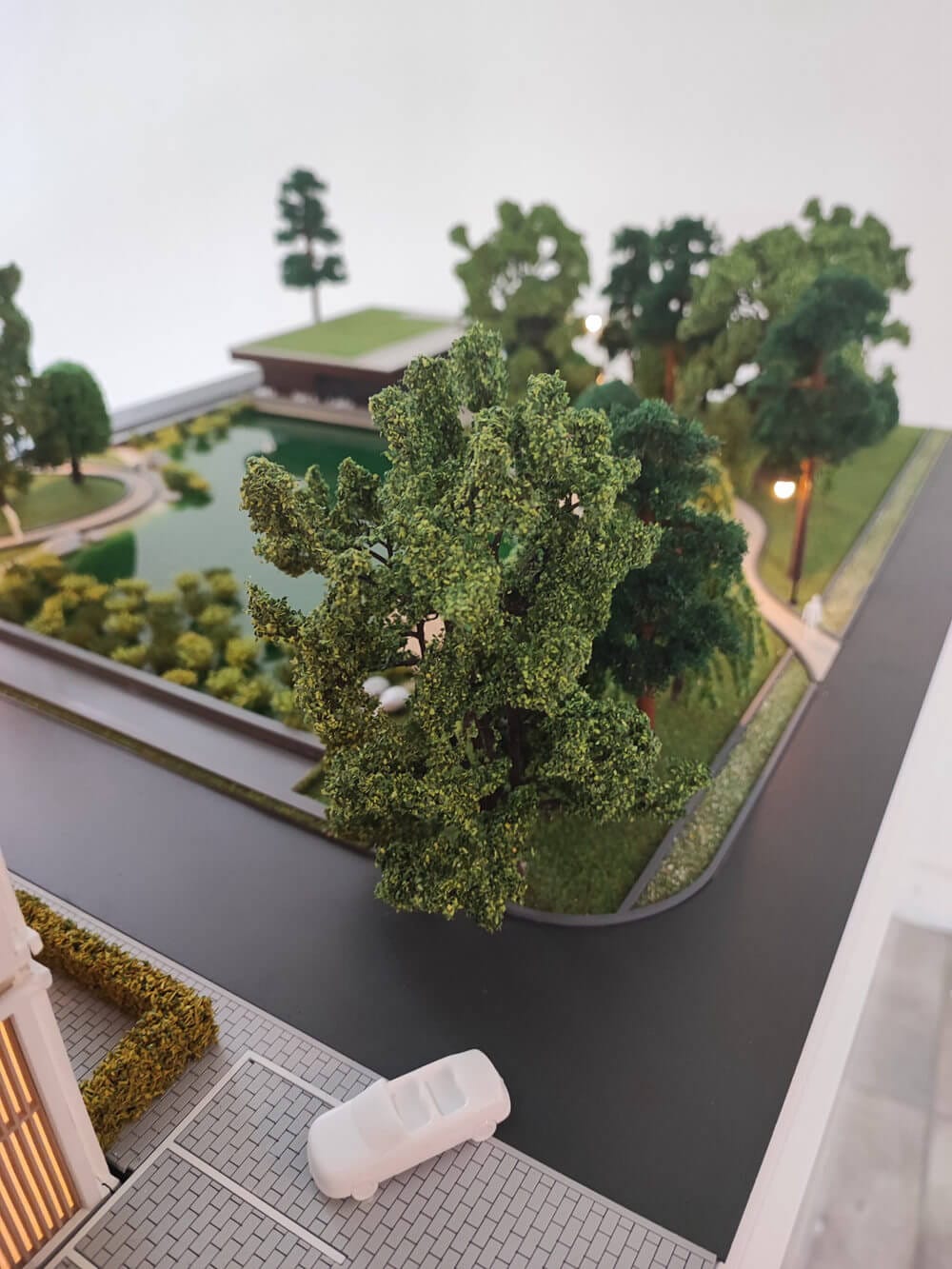
올바른 조경 모델 제작자를 선택하는 방법?
프로젝트의 성공을 위해서는 올바른 조경 모델 제작자를 선택하는 것이 중요합니다.. 신중한 검토가 필요한 중요한 결정입니다.. 다음 요소를 고려하십시오.:
- 경험과 전문성: 유사한 프로젝트를 위한 고품질 모델을 제작한 입증된 실적을 갖춘 모델 메이커를 찾으세요..
- 포트폴리오: 포트폴리오를 검토하여 장인정신과 세부 사항에 대한 관심을 평가하세요..
- 소통과 협업: 반응이 빠른 모델 메이커를 선택하세요, 의사소통, 프로세스 전반에 걸쳐 귀하와 협력할 의향이 있습니다.. 이는 다음과 같은 경우에 특히 중요합니다. 해외모델사업 관리.
- 기술 및 장비: 정확하고 상세한 모델을 생성하기 위해 최신 기술과 장비에 대한 액세스 권한을 보장합니다..
- 예산 및 일정: 예산 및 일정 요구 사항을 미리 논의하고 모델 제작자가 이러한 제약 조건 내에서 제품을 제공할 수 있는지 확인하세요..
완전한 심사 가이드를 보려면, 우리는 목록을 만들었습니다 10 모델 제작자를 고용하기 전에 물어볼 중요한 질문.
조경 모델 비용은 얼마입니까??
조경 모델의 비용은 크기와 같은 요인에 따라 크게 다릅니다., 복잡성, 세부 수준, 재료, 그리고 모델 메이커의 경험. 단순한 개념 모델은 수백 달러의 비용이 들 수 있습니다., 매우 상세한 프리젠테이션 모델의 비용은 수만 달러 이상일 수 있습니다..
정확한 견적을 받으시려면, 모델 제작자에게 프로젝트에 대한 자세한 정보를 제공하는 것이 중요합니다, 부지 계획 포함, 건축 도면, 원하는 수준의 세부 수준. 고품질 모델이 프로젝트에 가져올 수 있는 가치를 고려하는 것도 중요합니다., 의사소통 향상 등, 향상된 의사결정, 고객 만족도 향상. 전체 분석을 위해서는, 우리 가이드를 참조하세요, 포장 풀기 5 건축 모델 가격의 주요 요소.
| 모델 유형 | 대략적인 비용 | 설명 |
|---|---|---|
| 개념적/집합 모델 | $500 – $3,000 | 건물 형태 및 대지 레이아웃의 기본 표현. 제한된 세부 사항. |
| 상세한 아키텍처 모델 | $3,000 – $15,000+ | 중요한 건물 세부정보가 포함되어 있습니다., 조경, 및 사이트 기능. |
| 대규모/마스터플랜 모델 | $10,000 – $50,000+ | 여러 건물이 있는 넓은 지역을 나타냅니다., 하부 구조, 그리고 상세한 조경. |
| 프리젠테이션/판매 모델 | $5,000 – $20,000+ | 뛰어난 디테일을 갖춘 고품질 모델, 조명, 고객 프레젠테이션 및 판매를 위한 마무리. |
조경 모델 제작의 최신 동향은 무엇입니까?
조경 모델 제작 분야는 끊임없이 발전하고 있습니다., 사실성과 상호작용성의 경계를 넓히는 새로운 트렌드가 등장하고 있습니다.. 최신 트렌드 중 일부는 다음과 같습니다.:
- 디지털 모델과 물리적 모델의 통합: 실제 모델과 증강 현실의 결합 (AR) 그리고 가상 현실 (VR) 몰입적이고 상호작용적인 경험을 창조하는 기술.
- 지속 가능한 재료 사용: 모델 제작 시 환경에 미치는 영향을 줄이기 위해 친환경 소재와 공정을 사용합니다..
- 운동 모델: 움직이는 부품과 동적 요소를 통합하여 실제 프로세스를 시뮬레이션합니다., 교통 흐름, 물의 움직임 등.
- 3D로 인쇄된 풍경: 고급 3D 프린팅 기술을 활용하여 매우 상세하고 사실적인 지형과 식물 생성.
- 인터랙티브 조명 및 사운드: 첨가 전략적 조명 효과 모델의 현실감과 참여도를 향상시키는 사운드스케이프.
우리는 기사에서 이러한 흥미로운 새로운 영역을 탐구합니다., 모델 제작의 미래: 대화식 기술 및 AR.
결론: 조경 모델의 지속적인 힘
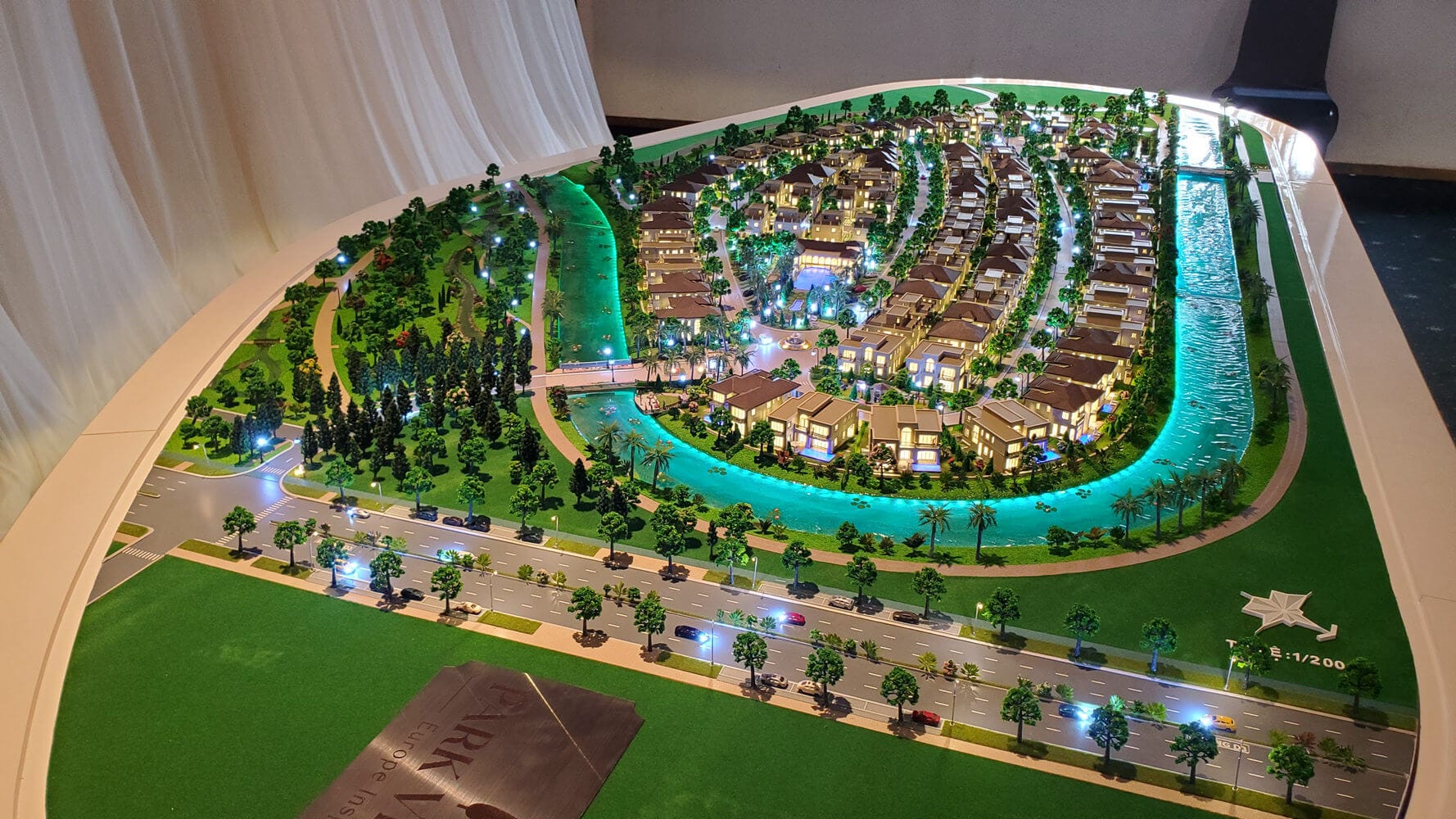
조경 모델은 건축가에게 없어서는 안 될 도구로 남아 있습니다., 디자이너, 건축 환경과 자연 환경을 시각화하고 이해하려는 모든 사람. 디지털 기술의 발전에도 불구하고, 물리적 모델의 촉각적, 3차원적 특성은 공간적 관계를 탐구하는 독특하고 매력적인 방법을 제공합니다., 디자인 아이디어를 전달하다, 창의력을 자극하고. 기술이 계속해서 발전함에 따라, 현실과 가상의 경계를 모호하게 만드는 더욱 혁신적이고 몰입도 높은 풍경 모델을 기대할 수 있습니다.. 상세한 내용인지 풍경 모델 거대한 도시나 단순한 풍경 모델 단일 건물 부지의, 이 미니어처 세계는 우리 주변 세계에 대한 우리의 이해를 형성하는 힘을 가지고 있습니다..
주요 테이크 아웃:
- 조경 모델은 공간 관계를 이해하는 실질적인 방법을 제공합니다..
- 건축과 디자인의 의사소통에 매우 중요합니다..
- 다양한 종류의 모델이 존재합니다, 다른 목적으로 봉사.
- 모델 생성은 다양한 재료와 기술을 포함하는 세부적인 프로세스입니다..
- 모델은 협업과 고객 이해를 향상시킵니다..
- 올바른 모델 제작자를 선택하는 것이 프로젝트 성공에 매우 중요합니다., 그리고 신중하게 이루어져야 하는 과정입니다, 특히 모델을 배송해야 하는 경우, 우리의 세부 사항에 따라 포장 및 운송 안내.
- 비용은 복잡성과 세부 사항에 따라 크게 다릅니다..
- 이 분야는 기술과 지속 가능성의 새로운 트렌드로 발전하고 있습니다..
매력적인 풍경 모델을 통해 비전을 현실화할 준비가 되었습니다.? 저희에게 연락하십시오 오늘 귀하의 프로젝트에 대해 논의하고 당사의 전문 모델 제작자가 귀하의 디자인에 대한 멋지고 유익한 표현을 만드는 데 어떻게 도움을 줄 수 있는지 알아보십시오..


